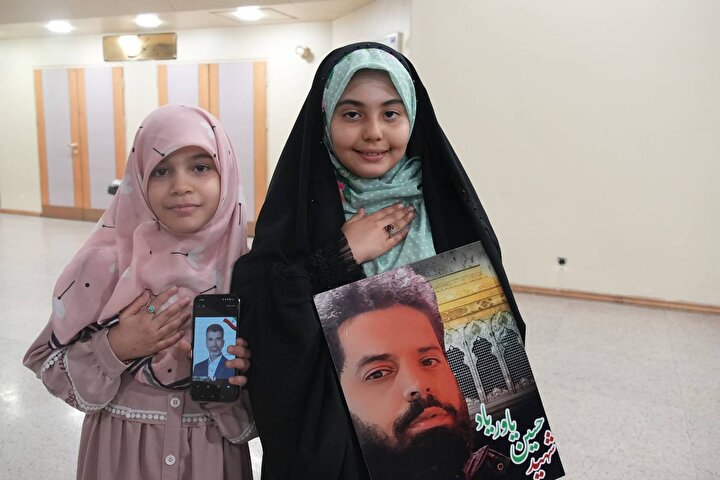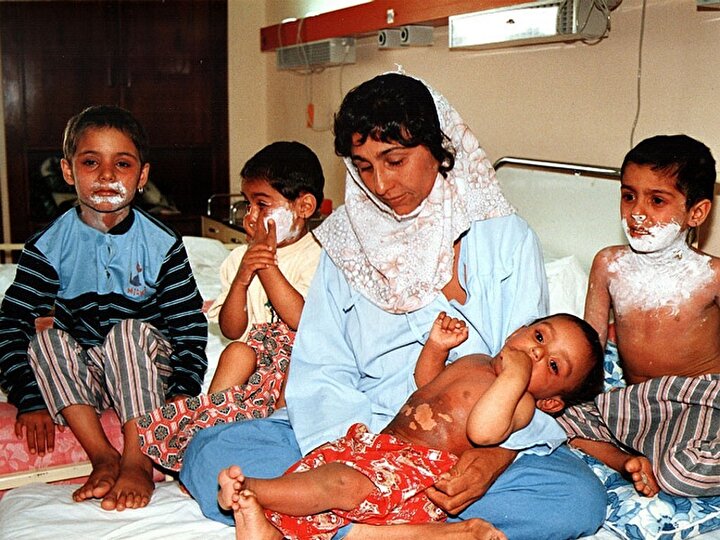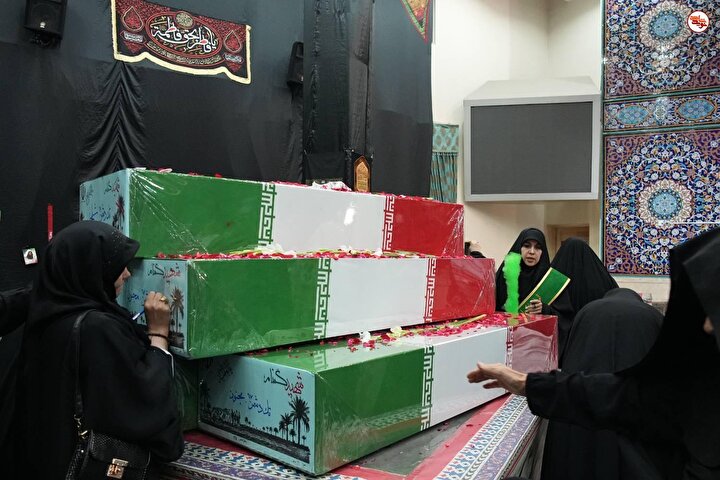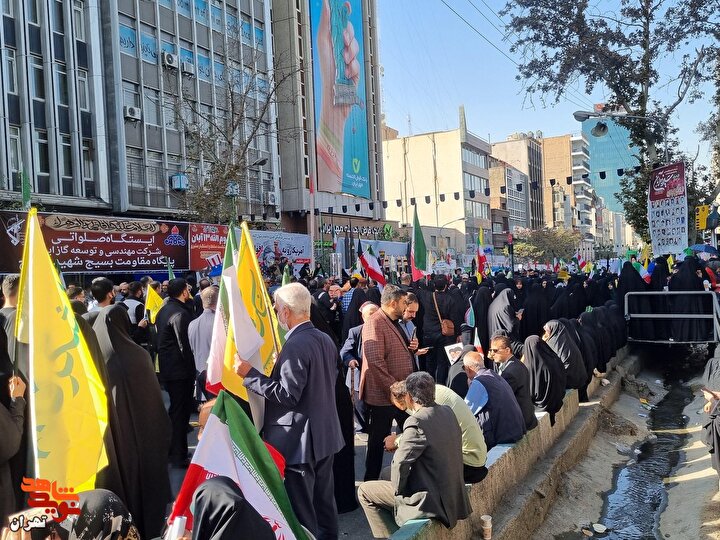
The Political and Social Activities of Her Holiness Zahra and Their Effects on the Islamic Revolution and the Sacred Defense War
Introduction:
Her Holiness Zahra is a perfect paradigm in all respects for all Muslim men and women even in martyrdom.
This article is intended to investigate men and women's setting Her Holiness Zahra as their paradigms in different scenes of the Islamic Republic of Iran and during the sacred defense war. For this aim at first I briefly investigate the presence of Her Holiness Zahra in the war and martyrdom scenes and then how her death and resistance has affected the Iranian fighters and women; these issues are discussed separately.
Chapter 1:
Her Holiness Zahra in the War and Martyrdom Fields
Her Holiness Zahra was not only precursor in scientific, worship, and educational fields as well as in other human values and ethical values she was also very good at war fields.
In this chapter we refer to some cases of her presence in the war and political scenes:
1. Announcing the messages of the martyrs and visiting the graves of the martyrs: this work of Zahra is in a way promoting martyrdom and aggrandizing the position of martyrs.
2. Fatima and Curing the Injured
Fatima attended Ohod war and it is mentioned in the history that: "women who have come from Medina were 14 persons one of whom was Fatima. They carried water and food with them to feed the fighters. They also attended the injured and were busy curing them.
We see that in addition to protecting her grandeur and value, when it was necessary, Fatima took part in the war and fought to defend the Islamic territories although this defense was in the form taking care of the injured fighters.
3. Fighting Until One Dies (Fatima in the field of war):
After the death of Prophet Mohammad the enemies of Ali and Fatima were able to bereave Ali of his rights and in this time Fatima entered the scene of politics and conducted war with the government in different ways until she martyred. Of these ways are:
A. Disagreement with asking for the oath of allegiance for Imam Ali, even after 40 days since the death of Prophet Mohammad.
B. Crying as the fighting device of Zahra during days and nights.
C: Stopping relationship with the first and second caliphs after the cruelty of the government of the time to Imam Ali and Zahra.
D. Her advice to bury her at night and her negative fighting with the enemy.
all the above mentioned cases are indeed social and political fighting that her holiness Zahra conducted against the cruel deeds of the cruel government of the time to Imam Ali and Zahra.
Fighting with the caliph in the Prophet Muhammad's Mosque due to conquering Fadak.
Complete Hijab in the War Fields
Her Holiness Zahra is the perfect example of a Muslim Woman, although she is placed in different social and political situations, but this could not separate her from her hijab.
She fought for the government of Amir Al Momenin for the occupation of Fadak with the Caliph and his companions but she did not quit her hijab.
It will be clarified from the previously mentioned materials that: Zahra combined her presence with Faith and belief and martyred for what he believed in.
Martyrdom the Beautiful Fate of Fighting
Her Holiness Zahra during the Oaths of Allegiance with the Caliph was seriously injured and martyred.
Yes, she was martyred in the way of her faith and ideas and became an everlasting paradigm for all the liberated men and women throughout the country.
Chapter 2:
The sons of Zahra are the Followers of the Red Line of Martyrdom
About the Iranian Brave men who set her holiness Zahra as their paradigms I have to mention first, that: although Fatima is female but what has made her a perfect example to follow is her humanitarian perfection and this is why she belongs to the entire world and thus does not belong to females or the males and accordingly all the human models are the same. Zahra has affected women and is their perfect model and she is also a perfect model for men. But we can summarize and investigate the ways that our martyrs were affected by the death of Zahra in two ways:
1. The Sacred defense War
In this regard I can refer to four cases:
A. Supporting Vilayat:
Our martyrs defended the country until their last minutes of life and died in this way. They were the lovers of Vilayat and at the order of our supreme leader the representative of Imam Zaman (A. T. F. Sh.) went to war and martyrdom.
Hijab, Purity and chastity:
Her Holiness Zahra kept her hijab till the last minutes of her life and our martyrs followed her model and considered Hijab as the worth and honor of Shiites and this is why they offered their lives and lost it for this aim and they advised their sistersin their wills to keep their Hijab.
C: Order to Patience
The third kind of getting models is the order to patience as Zahra did to Zeinab.
D: The Effect of Martyrdom
Our martyrs have been affected even in the way they were martyred. As it was said Zahra died because of the injuries in her side and some other injuries. Of the martyrs who were influenced by this death, I can name Sayed Mahmoud Asadi. He was born on the death day of Zahra and was martyred in the 5th Karbala Operation on his side.
During the sacred defense war, there were some other operations that were started by Ya Zahra and the Islamic Fighters showed a lot of braveries in their operations. In a way our fighters were seeking the revenge of their mothers' Zahra and followed her in their martyrdom.
2. The Islamic Republic of Iran:
People of our society came to the fore to fight the hateful regime of Shah and tried hard for its success. They came to the forefronts of the war with having the love's her Holiness Zahra in their minds to defend the Islamic Country and Islam and to follow her ways and in this way they martyred.
Following Zahra and being influenced by her ways needs no war fronts rather it can appear in any scene; wherever there is the opportunity to defend Islam, faith, and chastity as well as purity, there is martyrdom and Isar.
One of the dimensions of Republic fighting was to lead the war against the cultural attacks and lack of Hijab and to perform this many people died. Death for the sake of keeping one's Hijab and chastity in society can be tracked back to the influences and effects that our martyrs felt in their following the perfect model of martyrdom and generosity.
Setting Sedighe Kobra in the Scenes of War and Martyrdom as a perfect Paradigm to be followed by our Women:
We can summarize this effect in two sections:
1. Republic Efforts and Social Activities: (Here I mention four cases as example);
A. Embargo on Tobacco
B. Conditional Movement
C: Hijab
D. 17th of Shahrivar event in which several thousand women with their children
were killed. The martyrdom of these women had great effects on the society and
encouraged men greatly.
All the above cases show that our women are ready for martyrdom and are not afraid of any thing and are ready even to go to war before their men.
2. The Sacred Defense War:
Of the most obvious presence of women in the scenes of the sacred defense war the following cases can be highlighted:
A. Helping the Injured
B. Direct participation in the war.
C. Tolerating the Difficulties and Threats
As Zahra was relied on the helps and supports of God in all her social and political activities and was not afraid of being killed, our women have never evacuated the scenes and it was due to their active participation in the war that they are now able to be present in society in different activities along with keeping their chastity and Hijab.
Conclusion:
What is more important about setting Her Holiness Zahra as a perfect model for our martyrs and fighters to follow is the lesson of seeking martyrdom? Our male and female fighters and martyrs have all learned the lesson seeking martyrdom from her and one of its important aspects is the effects that her martyrdom had on our women. In spite of all the difficulty that our women had, they were not only able to take part in the martyrdom and war scenes but also they were able to keep and preserve their Hijab. Wherever it was necessary they were ready to give helps to the fighters; at the times of danger they were ready to accept the consequences and wherever it was mandatory they were ready to abnegate their lives.
Creating such scenes needs one to follow a great model which was effective on both male and females, as it was mentioned before, and this perfect model is no one except her holiness Fatima Zahra.
Sources:
1. Interpreting the Behaviorsof Fatima Zahra [Tahlil Sireh Fatima Zahra], Baba Zadeh Ali Akbar, Ansarian Pub. Co. winter 1374.
2. The appendix of Information [Ittlea'at] Newspaer 18 / 11 / 79.
3. Fatima Zahra, the Happiness of her Father's Heart. Hamedani Ahmad. Translated by: Hassan Eftekharzadeh, Badr Pub. Co. Soring 75.
4. Women's Message Monthly Magazine, Aban 76.
5. Women's Message Monthly Magazine, Khordad 79.
6. Infatuated By the Beauty of the Beloved [ Mahve Tamashaie Doost] (A Visiting the Cleric Martyrs of Zarand, Kerman), A Group of cleric fighters in Kerman, The Cultural Documents of the Islamic Republic. Spring.
Writer: Tahereh Irajinia
Her Holiness Zahra in the War and Martyrdom Fields
Her Holiness Zahra was not only precursor in scientific, worship, and educational fields as well as in other human values and ethical values she was also very good at war fields.
In this chapter we refer to some cases of her presence in the war and political scenes:
1. Announcing the messages of the martyrs and visiting the graves of the martyrs: this work of Zahra is in a way promoting martyrdom and aggrandizing the position of martyrs.
2. Fatima and Curing the Injured
Fatima attended Ohod war and it is mentioned in the history that: "women who have come from Medina were 14 persons one of whom was Fatima. They carried water and food with them to feed the fighters. They also attended the injured and were busy curing them.
We see that in addition to protecting her grandeur and value, when it was necessary, Fatima took part in the war and fought to defend the Islamic territories although this defense was in the form taking care of the injured fighters.
3. Fighting Until One Dies (Fatima in the field of war):
After the death of Prophet Mohammad the enemies of Ali and Fatima were able to bereave Ali of his rights and in this time Fatima entered the scene of politics and conducted war with the government in different ways until she martyred. Of these ways are:
A. Disagreement with asking for the oath of allegiance for Imam Ali, even after 40 days since the death of Prophet Mohammad.
B. Crying as the fighting device of Zahra during days and nights.
C: Stopping relationship with the first and second caliphs after the cruelty of the government of the time to Imam Ali and Zahra.
D. Her advice to bury her at night and her negative fighting with the enemy.
all the above mentioned cases are indeed social and political fighting that her holiness Zahra conducted against the cruel deeds of the cruel government of the time to Imam Ali and Zahra.
Fighting with the caliph in the Prophet Muhammad's Mosque due to conquering Fadak.
Complete Hijab in the War Fields
Her Holiness Zahra is the perfect example of a Muslim Woman, although she is placed in different social and political situations, but this could not separate her from her hijab.
She fought for the government of Amir Al Momenin for the occupation of Fadak with the Caliph and his companions but she did not quit her hijab.
It will be clarified from the previously mentioned materials that: Zahra combined her presence with Faith and belief and martyred for what he believed in.
Martyrdom the Beautiful Fate of Fighting
Her Holiness Zahra during the Oaths of Allegiance with the Caliph was seriously injured and martyred.
Yes, she was martyred in the way of her faith and ideas and became an everlasting paradigm for all the liberated men and women throughout the country.
Chapter 2:
The sons of Zahra are the Followers of the Red Line of Martyrdom
About the Iranian Brave men who set her holiness Zahra as their paradigms I have to mention first, that: although Fatima is female but what has made her a perfect example to follow is her humanitarian perfection and this is why she belongs to the entire world and thus does not belong to females or the males and accordingly all the human models are the same. Zahra has affected women and is their perfect model and she is also a perfect model for men. But we can summarize and investigate the ways that our martyrs were affected by the death of Zahra in two ways:
1. The Sacred defense War
In this regard I can refer to four cases:
A. Supporting Vilayat:
Our martyrs defended the country until their last minutes of life and died in this way. They were the lovers of Vilayat and at the order of our supreme leader the representative of Imam Zaman (A. T. F. Sh.) went to war and martyrdom.
Hijab, Purity and chastity:
Her Holiness Zahra kept her hijab till the last minutes of her life and our martyrs followed her model and considered Hijab as the worth and honor of Shiites and this is why they offered their lives and lost it for this aim and they advised their sistersin their wills to keep their Hijab.
C: Order to Patience
The third kind of getting models is the order to patience as Zahra did to Zeinab.
D: The Effect of Martyrdom
Our martyrs have been affected even in the way they were martyred. As it was said Zahra died because of the injuries in her side and some other injuries. Of the martyrs who were influenced by this death, I can name Sayed Mahmoud Asadi. He was born on the death day of Zahra and was martyred in the 5th Karbala Operation on his side.
During the sacred defense war, there were some other operations that were started by Ya Zahra and the Islamic Fighters showed a lot of braveries in their operations. In a way our fighters were seeking the revenge of their mothers' Zahra and followed her in their martyrdom.
2. The Islamic Republic of Iran:
People of our society came to the fore to fight the hateful regime of Shah and tried hard for its success. They came to the forefronts of the war with having the love's her Holiness Zahra in their minds to defend the Islamic Country and Islam and to follow her ways and in this way they martyred.
Following Zahra and being influenced by her ways needs no war fronts rather it can appear in any scene; wherever there is the opportunity to defend Islam, faith, and chastity as well as purity, there is martyrdom and Isar.
One of the dimensions of Republic fighting was to lead the war against the cultural attacks and lack of Hijab and to perform this many people died. Death for the sake of keeping one's Hijab and chastity in society can be tracked back to the influences and effects that our martyrs felt in their following the perfect model of martyrdom and generosity.
Setting Sedighe Kobra in the Scenes of War and Martyrdom as a perfect Paradigm to be followed by our Women:
We can summarize this effect in two sections:
1. Republic Efforts and Social Activities: (Here I mention four cases as example);
A. Embargo on Tobacco
B. Conditional Movement
C: Hijab
D. 17th of Shahrivar event in which several thousand women with their children
were killed. The martyrdom of these women had great effects on the society and
encouraged men greatly.
All the above cases show that our women are ready for martyrdom and are not afraid of any thing and are ready even to go to war before their men.
2. The Sacred Defense War:
Of the most obvious presence of women in the scenes of the sacred defense war the following cases can be highlighted:
A. Helping the Injured
B. Direct participation in the war.
C. Tolerating the Difficulties and Threats
As Zahra was relied on the helps and supports of God in all her social and political activities and was not afraid of being killed, our women have never evacuated the scenes and it was due to their active participation in the war that they are now able to be present in society in different activities along with keeping their chastity and Hijab.
Conclusion:
What is more important about setting Her Holiness Zahra as a perfect model for our martyrs and fighters to follow is the lesson of seeking martyrdom? Our male and female fighters and martyrs have all learned the lesson seeking martyrdom from her and one of its important aspects is the effects that her martyrdom had on our women. In spite of all the difficulty that our women had, they were not only able to take part in the martyrdom and war scenes but also they were able to keep and preserve their Hijab. Wherever it was necessary they were ready to give helps to the fighters; at the times of danger they were ready to accept the consequences and wherever it was mandatory they were ready to abnegate their lives.
Creating such scenes needs one to follow a great model which was effective on both male and females, as it was mentioned before, and this perfect model is no one except her holiness Fatima Zahra.
Sources:
1. Interpreting the Behaviorsof Fatima Zahra [Tahlil Sireh Fatima Zahra], Baba Zadeh Ali Akbar, Ansarian Pub. Co. winter 1374.
2. The appendix of Information [Ittlea'at] Newspaer 18 / 11 / 79.
3. Fatima Zahra, the Happiness of her Father's Heart. Hamedani Ahmad. Translated by: Hassan Eftekharzadeh, Badr Pub. Co. Soring 75.
4. Women's Message Monthly Magazine, Aban 76.
5. Women's Message Monthly Magazine, Khordad 79.
6. Infatuated By the Beauty of the Beloved [ Mahve Tamashaie Doost] (A Visiting the Cleric Martyrs of Zarand, Kerman), A Group of cleric fighters in Kerman, The Cultural Documents of the Islamic Republic. Spring.
Writer: Tahereh Irajinia



